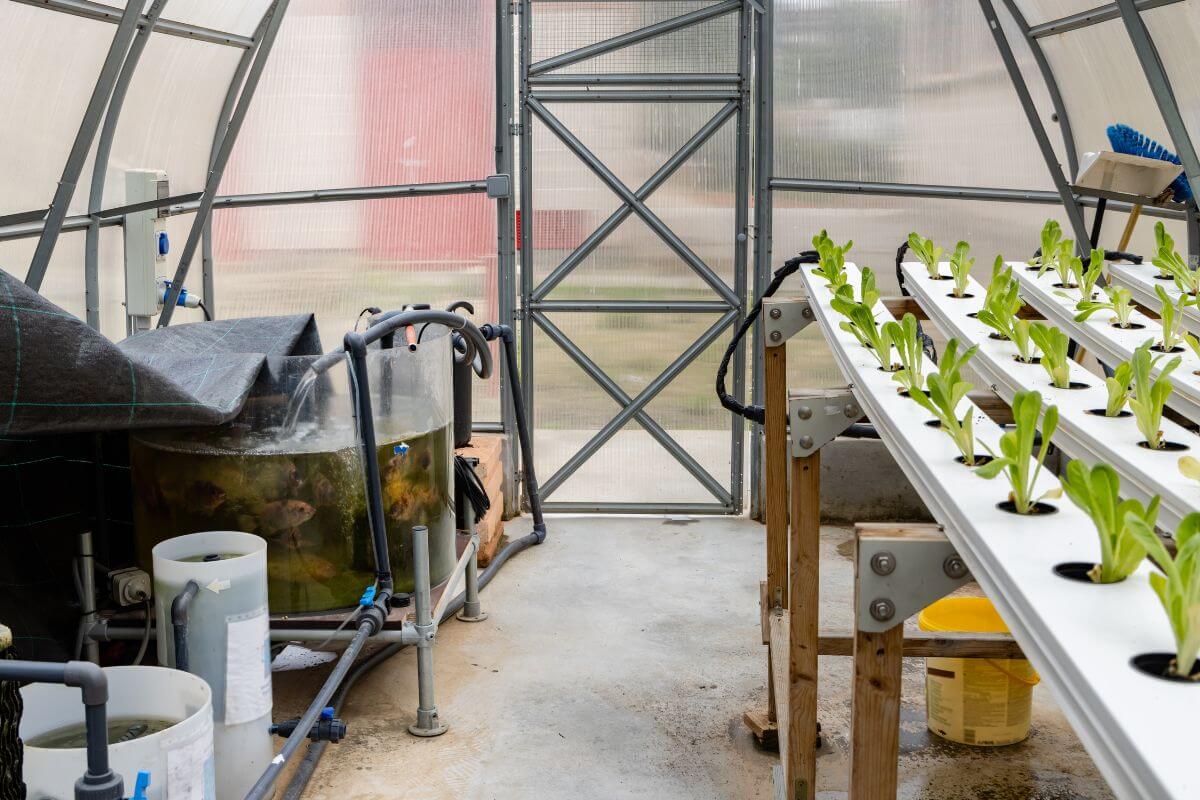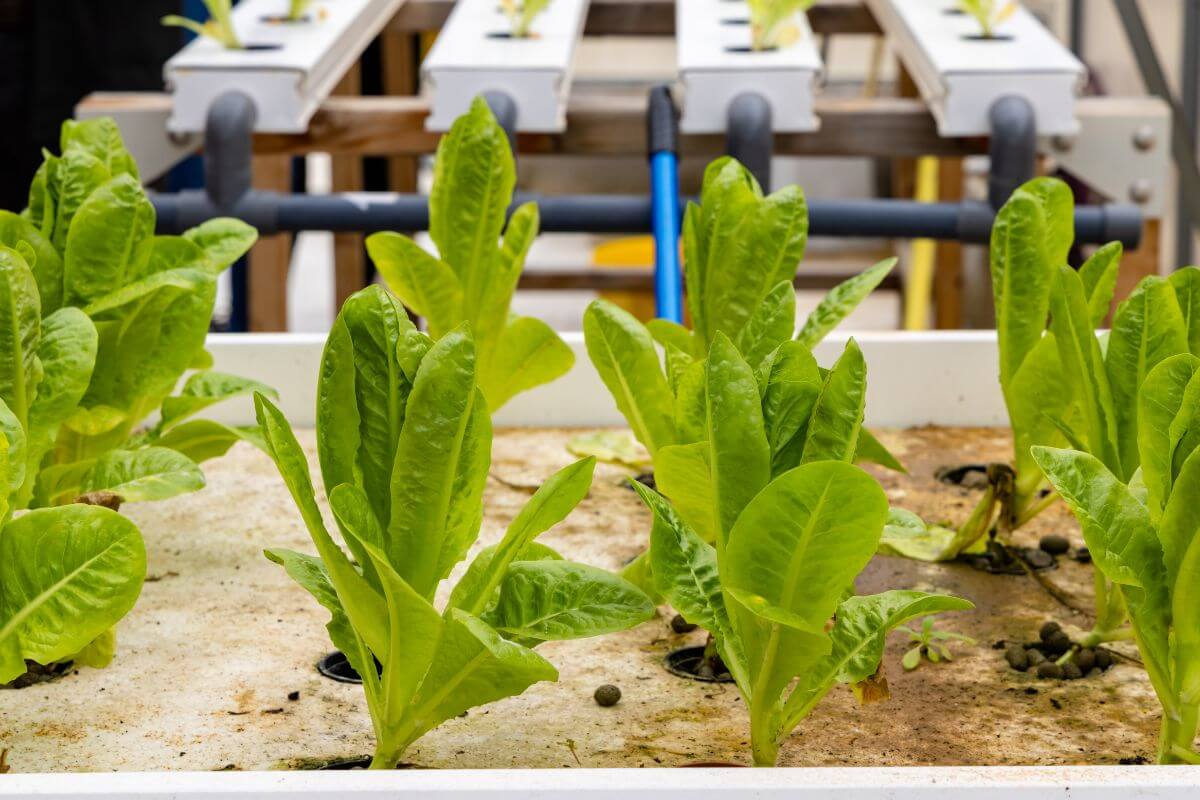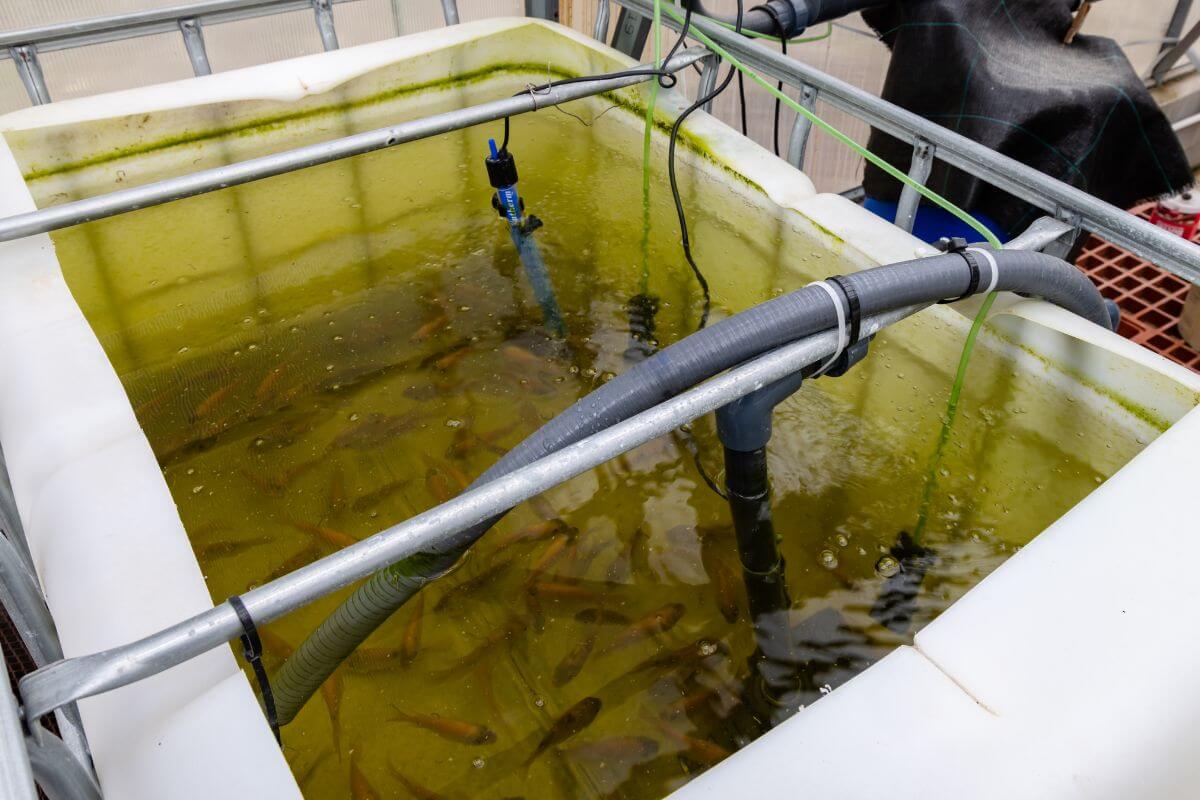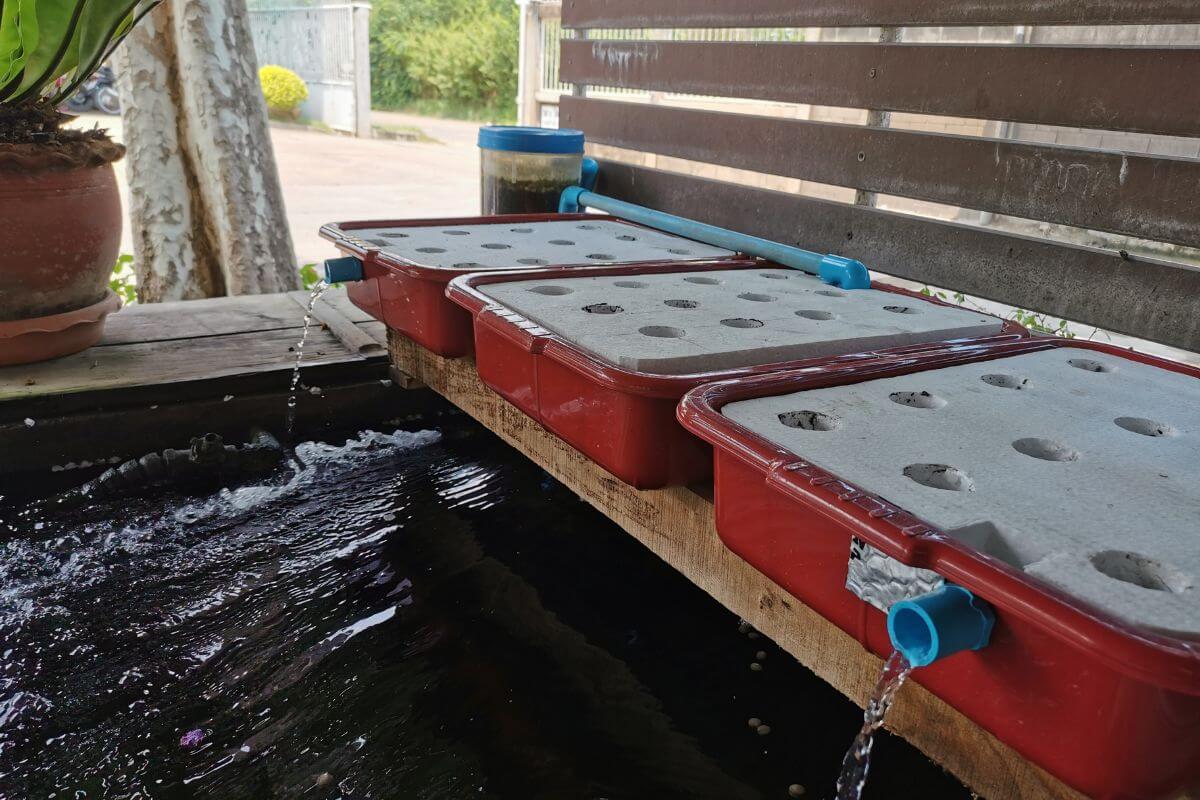Have you ever thought about growing plants and raising fish at the same time? This is exactly what aquaponics is about, and it’s not as crazy as it sounds.
Aquaponics is a method of growing food that mixes fish farming with water-based plant growing. It’s like having a mini ecosystem in your backyard. You’ve got fish in your tank and their waste feeds the plants. The plants then clean the water for the fish.
One thing to keep in mind about the process is balance. Too many fish can overwhelm the plants. Too few fish won’t provide enough nutrients. It takes some practice to get it just right.
Aquaponics is a fun way to learn about ecosystems and sustainability. Let’s figure out how its making waves in the gardening world.
- Related article: Discover Hydroponics
7 Key Takeaways on What Is Aquaponics
- Aquaponics combines fish farming with plant growth in a single system. Fish waste provides nutrients for plants, and plants help clean the water for fish.
- This method uses up to 90% less water than traditional farming because the water is continuously recycled between the fish tank and plant beds.
- There are various aquaponic setups, such as Deep Water Culture, Media Beds, and Vertical Towers, each suited for different spaces and plant types.
- You can grow a range of plants in aquaponics. You can choose from leafy greens, herbs, vegetables, and some fruiting crops.
- Ideal fish for aquaponics include tilapia, trout, and catfish. Each type has specific needs. Choosing the right fish is important for success.
- Aquaponics reduces the need for synthetic fertilizers and pesticides, conserves water, and can yield fresh produce year-round.
- Setting up and managing an aquaponic system can be complex and costly. It usually requires a careful balance of fish and plant needs, regular maintenance, and monitoring.
What Is Aquaponics and How Does It Work?
Aquaponics is a sustainable farming practice that lets you grow your own food and raise fish simultaneously in a symbiotic environment.
The fish produce waste and tiny helpers of bacteria turn it into plant food. Plants love this natural fertilizer. They soak it up through their plant roots to help them grow big and strong. As they do this, they clean the water for the fish.
This teamwork between fish and plants is pretty amazing. You’ll use way less water than regular farming and won’t need to buy chemical plant food. You could grow tasty herbs or leafy greens while raising tilapia or trout. Want to try it yourself? We recommend you start small with a home or hobby scale system.
Types of Aquaponic Systems

You might wonder how aquaponics differs from regular hydroponics. The main change is in the water system. Instead of plain water tanks for plants, aquaponics also creates the perfect home for freshwater fish to thrive. You can adapt most hydroponic systems to include fish.
Listed below are common types of aquaponic systems:
- Deep Water Culture System – Plants’ roots dangle in nutrient-rich water while fish swim in a separate tank. water is continuously pumped from the fish tank to the plant grow beds.
- Media Beds (Flood-and-Drain or Ebb-and-Flow) – Plants are nestled in gravel or clay pebbles (shop here). The bed floods with fish water, then drains. It’s like a mini tide for your plants.
- Nutrient Film Technique or NFT Systems – In this system, your plants’ roots get a constant trickle of fish water in a sloped channel.
- Vertical Towers – This stacks your plants high as water from a fish tank trickles down from the top, giving each plant a drink. It’s perfect if you’re tight on space.
- Raft Systems – Your plants float on foam rafts with their roots dangling in the water below. Water returns to the fish tank after it has flown to the rafts.
- Wicking Beds – A growing medium sits on top of the water source. The water is drawn up from below with a wick system to help you save on water usage.
Which system catches your eye? Think about your space, what you want to grow, and how much time you can spare when making a decision.
What Can You Grow in Aquaponics?

Ready to discover the amazing variety of plants you can grow in aquaponics? There’s more to it than just tossing some seeds in water. You’ve got to think about a few things first.
What kind of system are you working with? The setup matters. Then there’s the whole water situation. You want your fish and plants to be happy campers, so you need to match them right.
Here’s a quick list of plants that usually do well in aquaponics:
| Category | Plant |
| Leafy Greens | Lettuce, Spinach, Kale, Swiss Chard |
| Cruciferous Vegetables | Cabbage, Cauliflower, Broccoli |
| Herbs | Basil, Cilantro, Mint, Parsley |
| Vegetables | Tomatoes, Cucumbers, Peppers, Green Beans |
| Root Crops | Radishes, Beets |
| Fruiting Vegetables | Tomatoes, Peppers, Cucumbers |
If you’re just starting, go for the easy stuff. Your system needs time to adjust. I started with lettuce, and it was perfect. Lettuce is generally quick to grow and not too picky about nutrients. Other newbie-friendly options are spinach and basil.
Once your system’s been running for a while (we’re talking maybe 6 months), you can try other plants that need more nutrients.
What Types of Fish Thrive in Aquaponics?

Aquaponics offers many possibilities for growing various fishes. I’ve tried a few different species in my setup. Picking the right kind can make or break your system because not all are cut out for aquaponics. Some can be very demanding of optimal conditions. Others? They’re easygoing and won’t cause too much trouble.
Here’s a look at the types of fishes that thrive in an aquaponic system:
| Fish | Why They Thrive |
| Tilapia | Hardy and grows quickly |
| Trout | Suitable for cooler water temperatures |
| Catfish | Tolerant of various water conditions |
| Goldfish | Often used in smaller or ornamental systems, not for consumption |
| Bass | Can be raised in larger systems and adapt well to controlled environments |
| Guppies | Apart from being small, they are resilient and can tolerate a range of water conditions |
| Koi | They are hardy and come in a variety of colors, not for consumption |
Commercial aquaponic farms have a wider range of fish to choose from. Smaller and home aquaponic gardens don’t have as much flexibility.
What Are the Benefits of Aquaponics?
For the home grower, aquaponics has several advantages. But you also have to keep a close eye on everything to make sure it’s running smoothly.
Listed below are some benefits of aquaponics:
- Uses natural fertilizer from fish instead of synthetic ones
- Minimal water usage. Saves up to 90% more water than traditional farming
- Cost-saving nutrients from fish vs man-made nutrients
- Can grow a variety of crops year-round
- Recycles water, cutting your water bill
- No need for harmful pesticides or herbicides
- Uses less energy than conventional methods
- Produces higher yields than soil-based gardening
Did I mention how good homegrown tomatoes taste? And I barely lifted a finger once the system was up and running. With aquaponics, you’re not just growing food. You’re creating a sustainable mini-ecosystem.
What Are the Disadvantages of Aquaponics?
Setting up an aquaponic system isn’t all sunshine and rainbows. You need to juggle the health of both fish species and plants at the same time. It’s a bit like having two pets that depend on each other. If one gets sick, the other might catch it.
Here are some of the challenges of aquaponics:
- It’s harder to set up than hydroponics
- Takes time to get the balance right
- Needs more equipment
- More possibility of system failures
- Initial setup costs can be high
- Requires more space
Setting up an aquaponic system is trickier than hydroponics. With hydroponics, you just add water and nutrients. But with aquaponics, you need to be patient. It takes time to get the right balance of fish waste, bacteria, and nutrients.
- Learn more about Hydroponic vs Aquaponic Systems
You’ll need more gear too. A filtration system, water pump, and food for the fish are must-haves. If you’re up for a challenge and love the idea of organic produce, aquaponics can be rewarding. Just be prepared for a bit of a learning curve!
Aquaponics System Setup and Management Tips

I’m excited to share some tips on how to maintain a balanced ecosystem for your aquaponic setup. During the initial months, you’ll need to keep a close eye on things. It’s important to monitor water quality, temperature, nitrate levels, and ammonia levels as your ecosystem matures.
Here are some helpful hints I’ve learned:
- Always have a backup power supply (buy here) ready. You don’t want your fish gasping for air if the power goes out.
- Don’t overcrowd your fish tank. Too many fish can lead to disease outbreaks.
- Start small with plants that don’t need many nutrients. You can always expand later.
- Match your fish and plant needs for water acidity and temperature.
- Make sure there’s plenty of oxygen in the water for fish, bacteria, and plant roots.
- Feed your fish well and often. Happy fish mean happy plants!
I’ve found that aquaponics offers some great advantages over traditional agriculture. It uses less water and space while supporting both plants and aquatic species. Fish’s solid waste becomes a natural fertilizer for the plants in water.
To see what a large, commercial farm looks like, check out this video.
What Is Aquaponics Final Thoughts
Aquaponics is becoming a very popular practice in modern agriculture. It’s amazing how little water it needs compared to regular farming. Plus, you don’t have to buy any chemical fertilizers for the upkeep of your system. That’s good for your wallet and the environment.
You’ve got options like deep water culture, nutrient film technique, or vertical towers. Many hydroponic setups can be adapted to aquaponics. Each has its perks.
Setting up can be tricky at first and it might cost a bit upfront too. Remember to keep an eye on your system as it needs some TLC to thrive. But once you get the hang of it, it’s pretty easy to manage. You’ll be amazed at how productive your little ecosystem can be.
Start small and have fun with it. Experiment with different plants and fish. Aquaponics combines the best of hydroponics systems with fish farming.
What Is Aquaponics FAQs
1. What’s the Difference Between Hydroponics and Aquaponics?
Hydroponics is a great choice if you’re growing plants that need lots of nutrients. Why? Because you can easily tweak the nutrient solution to give your plants exactly what they crave.
Aquaponics works best when it comes to plants that don’t need as much. Think leafy greens and herbs. These plants thrive in the gentle nutrient balance that fish provide. But if you need more nutrients in your aquaponics setup, you can add more fish to your tank.
2. What Are the Main Components of Aquaponics?
Aquaponics needs three main components: fish, plants, and tiny microbes. These microbes or beneficial bacteria are really important as they act as the bridge between the two. Bacteria take the fish waste and turn it into food for the plants. Plants then filter the water for the fish.
3. What Fish Is Best for Aquaponics?
For small setups, I’ve had great luck with guppies. These little guys are tough and don’t need much space. You can also try your luck with goldfish, catfish, and koi. If you’re feeling adventurous, tilapia could be your go-to fish as well.
Widen your knowledge about smart garden and hydroponics with these helpful articles:






